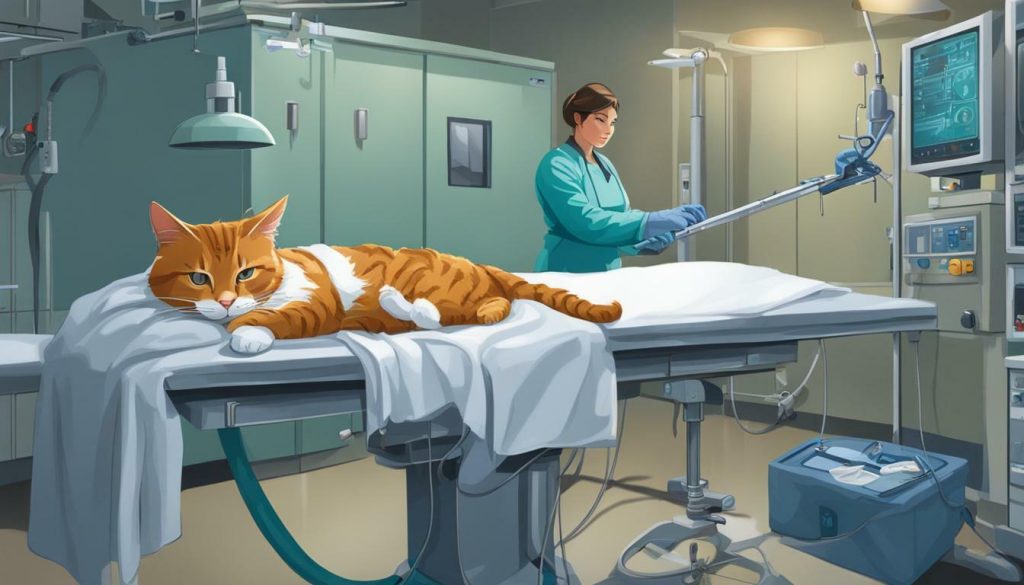As a cat owner, it’s important to pay attention to your feline friend’s behavior and physical changes. One of the critical aspects to observe is whether your cat is in heat. Knowing the signs of a cat in heat can help you provide the necessary care and attention to your pet during this specific period.
So how do you know if a cat’s in heat? Generally, female cats experience a heat cycle every two to three weeks during the breeding season, which typically lasts from spring to fall. During this period, they exhibit various signs that indicate they are in heat.
Some of the common signs of a cat in heat include increased vocalization or meowing, restlessness, rubbing against objects, and adopting a distinctive posture to attract a mate. Additionally, you may notice a change in your cat’s appetite and behavior, including her trying to escape from the house to mate.
Understanding the cat heat cycle is crucial for cat owners to provide appropriate care during this period. By recognizing the signs of a cat in heat, you can provide a controlled living environment and ensure the well-being of your pet.
Key Takeaways:
- A cat’s heat cycle occurs every two to three weeks during the breeding season.
- Signs of a cat in heat include meowing, restlessness, rubbing against objects, and adopting a distinctive posture to attract a mate.
- Changes in appetite and behavior are common in cats during their heat cycle.
- Observation of these signs is crucial for cat owners to provide appropriate care.
- Understanding the cat heat cycle is essential to ensure the well-being of your pet.
Understanding the Behavior of a Female Cat in Heat
Female cats experience heat cycles several times a year. These heat cycles can last from a few days to a few weeks and are marked by various behavioral and physiological changes. As a cat owner, it’s important to understand these changes so that you can provide the necessary care and attention to your furry friend.
One of the most noticeable changes in a female cat in heat is their behavior. During this time, cats become more affectionate and vocal, often rubbing against their owner’s legs and meowing loudly. They may also exhibit restless behavior, constantly grooming themselves and rolling around on the ground. Some cats may even present themselves with their hindquarters elevated in a mating position.
The duration of a cat’s heat cycle can vary, but on average, it lasts around seven days. However, if a female cat does not mate during this time, she may immediately enter into another heat cycle, causing stress and discomfort for both the cat and their owner.
To prevent this continuous cycling and unwanted litters, spaying your cat can be a beneficial solution. Not only does it prevent heat cycles, but it also reduces the risk of reproductive diseases later in life. It’s essential to understand the potential benefits and risks of spaying your cat, and to make an informed decision in consultation with your veterinarian.
By understanding the behavior of a female cat in heat, you can provide the necessary care and attention to your pet during this time. Whether you choose to spay your cat or not, it’s important to monitor their behavior and take steps to ensure their comfort and well-being.
Spaying a Cat: The Solution to Heat Cycles
As a cat owner, you may have experienced the disruptive behavior of a female cat in heat. One of the most common signs is excessive vocalization, which includes loud meowing, yowling, and even caterwauling. This behavior can be particularly distressing, not only for you but also for your neighbors. By spaying your cat, you can prevent heat cycles and reduce the likelihood of this behavior.
Spaying is a surgical procedure that removes the reproductive organs of female cats, effectively ending the heat cycle. This procedure can also have health benefits for your cat, including a lower risk of certain types of cancer and infections.
It’s important to note that male cats also exhibit behavioral changes during a female cat’s heat cycle. These changes may include increased aggression, vocalization, and marking behavior. By spaying your cat, you can also prevent unwanted litters and maintain a peaceful living environment for both you and your pets.
If you’re considering spaying for your cat, it’s important to consult with your veterinarian to determine the best timing for the procedure. Spaying can typically be performed when your cat is between 6 and 12 months old, although the exact timing may vary depending on your cat’s health and other factors.
Conclusion
As a cat owner, it’s essential to understand your pet’s behavior, especially when they’re in heat. By recognizing the signs of a cat in heat, you can provide the necessary care and attention to make this period easier for your cat.
Spaying your cat is a practical solution to prevent heat cycles, which can be stressful for both you and your cat. It also helps to control the population of stray cats and prevents the risk of health issues such as mammary tumors.
Female cats in heat often meow frequently and attract male cats with their scent. Understanding the behavior of male cats in heat is essential to prevent unwanted breeding and to keep the female cat safe.
In conclusion, by paying close attention to your cat’s behavior and considering spaying, you can create a comfortable living environment for your pet. It also helps to prevent the risks associated with mating and ensures that your pet’s health is always a top priority.
FAQ
Q: How do you know if a cat’s in heat?
A: Some signs that indicate a cat is in heat include yowling, increased affection, restlessness, rolling on the floor, and increased grooming. You may also notice a female cat assuming a mating position and spraying urine to attract males.
Q: What are the signs of a cat in heat?
A: Signs of a cat in heat may include vocalization, excessive attention-seeking behavior, increased activity, rubbing against objects, and a noticeable increase in urination. Female cats may also exhibit a distinctive posture called lordosis, where they lower their front half and raise their hindquarters.
Q: How long does a cat stay in heat?
A: The duration of a cat’s heat cycle can vary, but on average, it lasts about 7 to 10 days. However, if the female cat does not mate, she may enter another heat cycle shortly after the first one ends.
Q: What should I do if my cat is in heat?
A: If your female cat is in heat and you do not intend to breed her, it is recommended to spay her. Spaying is a safe and effective way to prevent future heat cycles, unwanted pregnancy, and certain health issues. It can also help reduce some of the behavioral changes associated with being in heat.
Q: What are the benefits of spaying a cat?
A: Spaying a cat has several benefits, including preventing unwanted pregnancies, reducing the risk of certain cancers, eliminating the heat cycle, and curbing undesirable behaviors such as yowling and spraying. It also helps control the cat population and promotes the overall health and well-being of your pet.
Q: How does a male cat behave during a female cat’s heat cycle?
A: Male cats may exhibit increased restlessness, vocalization, and aggression during a female cat’s heat cycle. They may also spray urine and try to escape from the house to find a mate. It is important to keep male and female cats separated during this time to prevent unwanted pregnancies.











